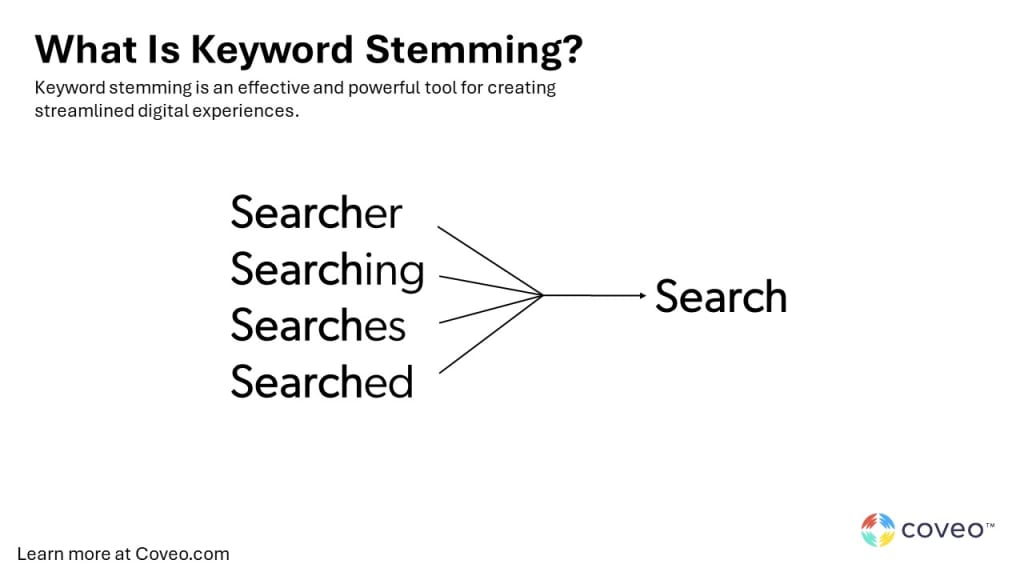Have you ever searched for something like “sneaks” on your online store and been surprised when nothing shows up in the results? What you’re after is obvious, at least to you and other in-the-know people:
You’re shopping for sneakers. Shoes.
Not so obvious to the site’s search algorithm, because it’s not configured to handle the keyword stem and related terms. This is a common (and disappointing) experience that many users have when performing a keyword search on a website or app that isn’t supported by a modern search engine.
We tend to think site search should work like it does on websites like Google — automatically connecting concepts and showing us useful, relevant results. But many search tools work by matching the exact original keyword we type to content word-for-word, something that’s known as keyword search or lexical search.
That’s why your search for “sneaks” returns nothing in the search results. You didn’t use the exact match keyword.
Enter keyword stemming as one of many valuable solutions to this common search issue.
Keyword stemming is the process of relating words to their base or “root” or word stem so searches connect concepts more intelligently. By implementing stemming, sites can deliver results more akin to Google, where a search for “sneaks” surfaces results based on related words like sneakers, running shoes, and slippers.
In this post, we’ll unpack how stemming works, why integrating a stemming algorithm into your website can improve search relevance and content discovery for your visitors, and what it all means for search engine optimization (SEO).
What is Keyword Stemming and Why Does It Matter?
Stemming is the process of reducing words down to their base or “root” form. For example, Coveo’s search engine stems the words “searched,” “searching,” and “searched” to the common stem word “search.”

Stemming matters for digital experiences because it allows queries to match documents that may not contain the exact keyword searched, but do contain different forms of that root word.
Coveo’s keyword stemming feature currently applies to words with four or more characters. It works by expanding the query variations of the root word, but also similar keywords that are semantically relevant.
This query expansion connects concepts in a relevant yet broader way. Without stemming enabled, a keyword or lexical search is very rigid, with the system looking only for precise words or phrases matched exactly.
By factoring in stemmed keywords, the search experience can surface more relevant content, related posts, and recommendations, not just pages that contain the exact term or query.
How Does Keyword Stemming Impact the Digital Experience?
Stemming transforms basic keyword searches in a way that connects concepts together – similar to how web search engines like Google work. This makes site search more user friendly and relevant.
Here are a few ways stemming improves the digital experience:
- Adds relevancy: Surfaces content that matches what people are looking for, even if they don’t get the query quite exactly right. Reduces “zero results” searches (when a search produces no results for the user).
- Aids discovery: Connects a search query to relevant materials that users might not have discovered (or even known to look for). Since stemming uses the root word or words of a keyword to find supplementary sources, it opens new doors to relevant content.
- Boosts flexibility: Streamlines the digital experience. Users don’t need to get their query 100% right or distinguish from singular or plural versions of a term. Stemming matches content despite small fluctuations. More flexibility = less hassle.
- Reduces frustration: Since stemming surfaces more complete results versus dead ends, it reduces searcher frustration. Your audience doesn’t have to keep rewriting queries over and over, getting them answers they need faster and with less effort.
Reducing the frustration on your site search is a big deal. First of all, it’s where a lot of people go when they need information. Our research shows that 43% of site users go straight to the search bar when they have a specific goal in mind.
When they get to your site search, people expect it to make finding what they want easy. The same research revealed that 63% said that finding what they sought in just a few clicks (alongside supporting content) would have the strongest impact on what they thought of a company.

How Does Keyword Stemming Impact SEO and Rankings?
This is an interesting question, because you’re not stemming your data/content — you’re employing keyword stemming in the search index/search platform that you use. Within the context of website search, for example, you can use Coveo’s stemming functionality to improve the overall experience (as described above).
Within the context of SEO and ranking your content on external search engines, stemming is a lot less important than the nature of the content itself. For a two important reasons:
- Keyword stemming is not a ranking factor for Google and other external search algorithms (Search Engine Journal).
- Most search engines rely on natural language processing (NLP), machine learning (ML), and other technologies to determine context and intent for search queries. That said, implementing semantic search principles may do more for your site’s SEO efforts.
All of which means you’ll do far more for your site’s SEO by focusing on detailed, authoritative, and well-organized site content. This is what today’s search engines look for to determine the most relevant results. How they rank is based in large part on user context and intent.
What Are the Different Types of Keyword Stemming Algorithms?
You’ll encounter various keyword stemming algorithms that take different approaches to stemming. These include suffix stripping, statistical analysis, and rulesets to normalize keywords. Factors like speed, accuracy, and multilingual support impact the effectiveness of each approach for text processing pipelines.
Here’s a high-level overview of the most common stemmer algorithms:
- Porter’s stemmer: One of the most popular and effective algorithms. Eliminates common suffixes to get to the root word form.
- Snowball stemmer: Improves on Porter’s stemmer by handling multiple languages better.
- Lovins stemmer: Takes an aggressive approach by removing the longest suffix first.
- Dawson stemmer: Builds on Lovins stemmer with an indexing system to remove suffixes.
- Krovetz stemmer: Converts different word forms to their singular present tense forms.
- Xerox stemmer: Relies heavily on lexicons to over-stem words down to their roots.
- N-gram stemmer: Breaks words into consecutive letter pairs and uses statistics to relate similar words.
- Lancaster stemmer: Uses external rule files and aggressive iterative truncating.
- Regexp stemmer: Allows custom regular expression rules to be defined for suffix removal.
What Are The Common Misconceptions About Keyword Stemming?
Stemming is a powerful technique for improving the search functionality of digital experiences. But there are some common misconceptions about how to implement it, which can impact the relevance of your search results.
Here are the top misconceptions about keyword stemming:
- It will lead to irrelevant or unrelated search results: It’s true that stemming expands a search, leading to more matches across your content repository, but this doesn’t mean you’re facing a barrage of irrelevant results. When properly implemented, stemming matches queries to relevant supplemental materials, not tangential content.
- Stemming creates query expansion anarchy: Effective stemming algorithms normalize words to root forms in a controlled way. They achieve this by using predefined rules and logic which prevents “over-stemming” queries that could lead to broad or irrelevant results.
- Stemming is unwieldy for ecommerce: On the contrary, stemming helps manage large indexes and product catalogs, where creating exhaustive thesaurus rules would be impossible. Well-formatted data combined with stemming mitigates this issue, allowing you to surface relevant results without manually creating exhaustive rules.
- Stemming causes “result collision”: Result collisions occur when multiple results from a search query are too similar or identical. This causes redundant information in the search results presented to the user. Stemming typically starts normalizing words at 5+ characters to avoid result-collisions. And while stemming does not work out-of-the-box for exact-phrase searches, it can be enabled to connect relevant phrasal concepts which further reduce result collisions.
Stemming is an incredibly useful tool, but it’s not a magic bullet. When done right, with proper keyword variations, it effectively connects the dots between search queries and content in helpful ways. en done right, it effectively connects the dots between search queries and content in helpful ways.
Stemming Is One Of Many Steps to Search Relevance
On its own, stemming doesn’t guarantee relevance since relevance is contextual. What satisfies one searcher may not satisfy the next. There is no one-size-fits-all approach.
Still, digital experiences should emulate the kind of relevancy that customers are used to getting from search engines like Google, aiming to deliver useful, personalized results, limit redundancies, and eliminate blank results pages.
On that note, remember that keyword stemming isn’t a ranking factor for Google. If ranking content in external search engines is your objective (SEO strategy), your priority should be to create stellar content that’s credible, context-rich, and well organized. You’ll want to focus on keyword research and keyword variation, while avoiding keyword stuffing at all costs (Google will ding you for that).
Achieving a truly relevant search result requires looking beyond basic keyword matching to connect word variations more intelligently to content. That’s why AI-powered platforms like Coveo use machine learning to match a root keyword with related keywords, surfacing the most appropriate content for a given search.
It’s also important to continuously monitor search relevance. Understanding what search relevance metrics to measure allows you to fine-tune your stemming approach, ensuring that stemming remains impactful in helping your website visitors find more of what they need.
Ultimately, this translates to happier customers, higher conversions, and alignment with your business objectives.










